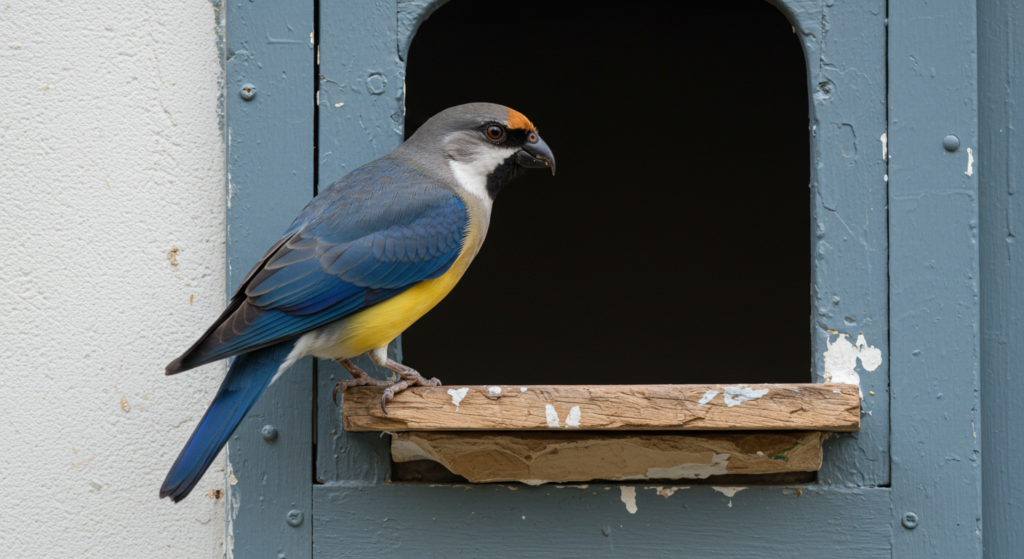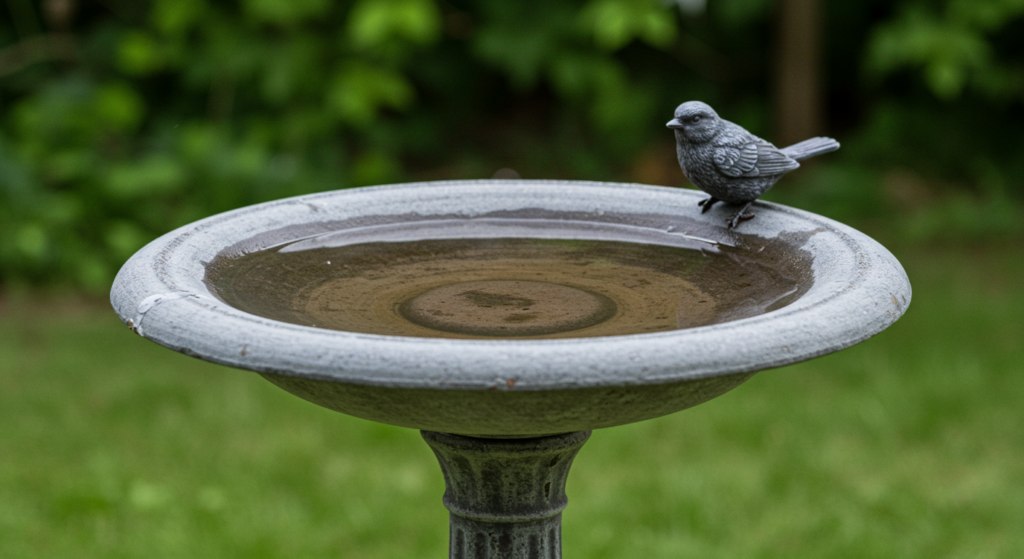Have you ever wondered how to keep your bird bath vibrant while ensuring it’s safe for its feathered visitors? Bird baths are charming garden additions, providing birds a place to drink and bathe.
However, picking the right paint is critical to protect birds and maintain the bath’s appeal. This detailed guide explores safe paints for bird baths, diving into non-toxic options, application methods, and maintenance tips. By the end, you’ll be ready to create a bird-friendly sanctuary that’s both practical and beautiful.
Key Takeaways:
- Non-toxic paints are vital for bird safety.
- Water-based acrylics and epoxy paints offer durability and safety.
- Always choose low or zero-VOC paints to avoid toxic chemicals.
- Regular cleaning and maintenance extend the life of painted bird baths.
- Avoid paints with lead, zinc, or heavy metals to protect birds.
Why are Safe Paints Essential for Bird Baths?
To start, bird baths attract diverse species, from sparrows to cardinals, all relying on clean water. Consequently, unsafe paints can release harmful chemicals into the water, endangering birds that drink or bathe. For example, toxic substances may cause poisoning or feather damage. Therefore, selecting non-toxic, bird-safe paints prevents these risks. Additionally, safe paints withstand outdoor conditions, keeping the bird bath functional and attractive.
As Rachel Carson, a renowned environmentalist, noted, “In nature, nothing exists alone.” Thus, choosing safe paints supports your garden’s ecosystem.
List of Non-Toxic Paints:
Next, non-toxic paints are free from harmful components like lead, heavy metals, or volatile organic compounds (VOCs). Specifically, these paints are safe for humans, animals, and the environment. For bird baths, non-toxic paints ensure birds can interact with the surface without ingesting dangerous substances. Moreover, they often carry certifications from trusted organizations like the American Society for Testing and Materials (ASTM) or Green Seal, verifying their safety.
When shopping, seek labels like “non-toxic,” “low VOC,” or “zero VOC.” In particular, water-based paints such as acrylics are preferred for their low toxicity and ease of use.
Exploring Types of Safe Paints for Bird Baths:
Characteristics of Water-Based Acrylic Paints:
Firstly, water-based acrylic paints are a top choice for bird baths due to their favorable properties:
- Non-Toxic: Safe for birds with low or zero VOCs.
- High Durability: Resists UV rays and rain, ideal for outdoor use.
- Ease of Use: Dries quickly and cleans up with soap and water.
- Best For: Concrete and ceramic bird baths.
Opt for acrylics labeled as non-toxic and outdoor-suitable. For instance, brands like Benjamin Moore and Sherwin-Williams provide reliable options. Apply thin coats for a smooth finish and allow ample drying time.
Features of Epoxy Paints:
Secondly, epoxy paints offer a robust coating with unique benefits:
- Non-Toxic When Cured: Low VOCs after full curing, safe for birds.
- Very High Durability: Resists cracking, peeling, and harsh weather.
- Application Note: Requires ventilation during application due to fumes.
- Best For: Concrete and metal bird baths.
Select two-part epoxy paints designed for outdoor use. Follow mixing and curing instructions carefully to ensure a bird-safe surface.
Attributes of Milk Paints:
Additionally, milk paints, made from natural ingredients, provide an eco-friendly option:
- Non-Toxic: Zero VOCs, free from synthetic chemicals.
- Moderate Durability: Best with a sealant for outdoor longevity.
- Aesthetic: Matte finish suits natural garden settings.
- Best For: Wood and unfinished surfaces.
Milk paints work well on porous materials. Use a non-toxic, water-based sealant to enhance durability.
Paints to Steer Clear Of:
Importantly, some paints pose significant risks to birds and must be avoided. For instance, oil-based paints often contain high VOCs and heavy metals, which can contaminate water. Similarly, paints with lead, zinc, or cadmium are toxic and can cause severe health issues in birds. Therefore, always check labels to confirm the absence of these substances.

Moreover, avoid paints not rated for outdoor use, as they may degrade quickly, releasing chemicals. Likewise, refrain from using spray paints unless they’re explicitly labeled as non-toxic and low VOC.
Selecting the Perfect Paint:
Moving forward, choosing the right paint involves verifying safety certifications and matching the paint to the bird bath’s material. For example, concrete bird baths need paints that adhere to porous surfaces, while metal ones require rust-resistant options. Consequently, prioritize paints with clear, non-toxic labeling.
Additionally, consider your local climate. In humid areas, opt for mold-resistant paints. In sunny regions, select UV-resistant options to prevent fading. Before committing, test a small area to ensure adhesion and color satisfaction.
The Bible offers guidance on caring for creation: “The Lord God took the man and put him in the Garden of Eden to work it and take care of it” (Genesis 2:15). Thus, selecting safe paints reflects this responsibility.
Preparing the Bird Bath for Painting:
Before painting, thorough preparation ensures a lasting result. To begin, clean the bird bath meticulously to remove dirt, algae, or old paint. Use a mild detergent and scrub brush, then rinse thoroughly. Next, allow the surface to dry completely.
For rough areas, sand lightly to create a smooth base. If old paint is present, use a wire brush or sandpaper to remove flaking sections. Additionally, apply a non-toxic primer if recommended by the paint manufacturer. Primers improve adhesion and durability, especially on slick surfaces like metal.
Step-by-Step Guide to Painting a Bird Bath:
Now, painting a bird bath requires careful steps to achieve a safe and appealing finish. Follow these guidelines for the best outcome.
Step 1: Gather Supplies:
Initially, collect non-toxic paint, brushes, rollers, painter’s tape, and drop cloths. Ensure all materials are bird-safe. For safety, wear gloves and a mask during application.
Step 2: Apply Painter’s Tape:
Then, use painter’s tape to cover areas you don’t want painted, such as decorative elements. This ensures clean lines and protects intricate designs.
Step 3: Apply the First Coat:
Subsequently, use a brush or roller to apply a thin, even coat of paint. Work in small sections to avoid drips. Allow the first coat to dry fully, per the manufacturer’s instructions.
Step 4: Add Additional Coats:
Next, apply one or two more coats for complete coverage. Thin coats prevent cracking and ensure a smooth finish. Ensure each coat dries thoroughly.
Step 5: Seal the Surface (Optional):
For extra protection, apply a non-toxic, water-based sealant. Sealants enhance durability and guard against weathering. Confirm the sealant is fully cured before adding water.
Step 6: Inspect and Cure:
Finally, check for missed spots or imperfections. Allow the paint to cure for at least 48 hours, or as directed. This ensures the surface is safe for birds.
More Interesting: Is Bird Poop Good Luck? Myth vs. Reality Explained!
Maintaining a Painted Bird Bath:
To keep the bird bath safe and inviting, regular maintenance is essential. For instance, clean the bird bath weekly with a mild soap solution to remove algae and debris. Avoid harsh chemicals that could damage the paint or harm birds.

Additionally, inspect the paint every few months for chips or fading. Touch up small areas with the same non-toxic paint to maintain protection. Depending on wear, repaint the entire bird bath every 2-3 years.
John Muir, a celebrated naturalist, remarked, “When we try to pick out anything by itself, we find it hitched to everything else in the Universe.” Thus, maintaining a bird bath connects us to the broader ecosystem.
Environmental Considerations:
Furthermore, choosing eco-friendly paints benefits both birds and the planet. Low-VOC paints reduce air pollution, while natural options like milk paint minimize synthetic waste. To protect water sources, dispose of leftover paint responsibly at local recycling centers.
Also, consider the bird bath’s placement to reduce environmental impact. Position it away from pesticide-treated plants to keep water clean. Providing shade prevents algae growth, reducing cleaning frequency.
Common Mistakes to Avoid:
Despite seeming straightforward, painting a bird bath can involve pitfalls. For example, rushing the drying process can cause uncured paint to release harmful fumes. Similarly, skipping surface preparation leads to peeling due to dirt or old paint.
Moreover, never use indoor paints for outdoor bird baths, as they lack weather resistance. Likewise, avoid over-painting, which creates thick, uneven layers prone to cracking.
Benefits of a Well-Painted Bird Bath:
Ultimately, a well-painted bird bath enhances your garden’s beauty and utility. Vibrant colors attract more birds, enlivening your backyard. Safe paints ensure birds can drink and bathe without risk, supporting local wildlife.
Additionally, durable paints extend the bird bath’s lifespan, saving on replacement costs. Plus, a well-maintained bird bath boosts property value, appealing to eco-conscious buyers.
Henry David Thoreau eloquently stated, “Heaven is under our feet as well as over our heads.” A safe bird bath brings a slice of heaven to your garden.
More Interesting: Argentina Duck Hunting Adventures – Top Destinations!
Seasonal Considerations for Painting:
Moreover, timing your painting project matters. Spring or early summer is ideal, as mild temperatures aid drying and curing. In contrast, avoid painting in extreme heat or cold, as these conditions affect paint adhesion.
Before winter, inspect the bird bath for damage. Touch up any chips to prevent water seepage, which can crack the surface during freezes. This proactive approach ensures year-round safety.
Community and Wildlife Impact:
Beyond your garden, a safe bird bath fosters community engagement. For example, birdwatchers may visit, sharing tips and appreciation for local wildlife. Additionally, safe bird baths contribute to conservation by providing clean water sources during droughts.
Encourage neighbors to adopt bird-safe practices. Share your knowledge about non-toxic paints to promote eco-friendly gardening. Together, these efforts strengthen local ecosystems.
The Dalai Lama wisely noted, “Our prime purpose in this life is to help others.” By using safe paints, you support the birds that grace your garden, fostering harmony with nature.
FAQs About Safe Paints for Bird Baths:
Are all non-toxic paints safe for birds?
Not all non-toxic paints are bird-safe. Therefore, check for low or zero VOCs and avoid heavy metals. Look for outdoor-rated paints with safety certifications.
How often should I repaint my bird bath?
Repaint every 2-3 years or when chipping or fading appears. Regular maintenance extends the paint’s life.
Can I use spray paint on a bird bath?
Only use spray paint labeled as non-toxic, low VOC, and outdoor-safe. Ensure proper ventilation and curing.
What colors are best for bird baths?
Natural colors like blue, green, or earth tones attract birds. Avoid bright whites, which may deter them.
Final Thoughts:
Crafting a safe and beautiful bird bath begins with selecting the right paint. Water-based acrylics, epoxy paints, and milk paints offer non-toxic, durable options that protect birds and enhance your garden. By following meticulous preparation, application, and maintenance steps, you can create a bird-friendly oasis that endures.
Always prioritize low-VOC, outdoor-rated paints and avoid harmful substances like lead or zinc. With these insights, your bird bath will become a safe sanctuary for feathered friends, seamlessly blending into your eco-conscious lifestyle.
Read More:
- Must Read: Cardinals Appear When Angels Are Near!
- Must Read: 20 Types of Hawks in Wisconsin & How to Identify!
- Must Read: Top 10 Mythical Birds and Creatures!
